Text
My 6-Week Ornithology Conservation Placement in The Peruvian Amazon
So, after only a years long break, I'm back posting about another trip to Peru! This time I was away for a longer, 6 week, period for a far more in depth kind of research.
I started my journey by going through 4 separate airports to finally get to my destination. Thankfully, the journey there was without issue, although I can't sat the same for my way home!
I started my placement by getting to know coordinators and also the camp that I'd be staying at. However, first, I had to get to the camp. This involved a 2 hr car journey from Puerto Maldonado Airport, followed by a short boat ride into the Amazon. Once at camp, I was made familiar with the facilities. Working plumbing for both modern toilets and showers was definitely something I wasn't expecting, even if the showers only had freezing cold water, haha. Every one of the coordinators were lovely and made me feel welcomed, as well as the other interns who all seemed eager to get to work.
I joined the organisation, Fauna Forever, in order to do an ornithology internship involving mist netting understory birds. It didn't take long to get to work as the morning after I arrived we were up at 4am getting ready to set up the nets for the first time. It took some getting used to, but by the end of the first week, I had gotten into the swing of things.

The long hours, from 05:00-13:00, were worth it though, as every day I got to see so many new species. For the first few weeks I was in training so didn't get to handle any of the birds, only wrote down the data, but it was still rewarding learning how to use all of the tools correctly and how I would eventually handle the birds.

A few weeks after getting accustomed to the process, I was finally able to start handling the birds. Although it was very daunting at first, the coordinators teaching me were very patient and always encouraged me to be slow and steady so as to not harm any of the birds. Some of the species that I was able to see, my favourite being the royal flycatcher, were once in a lifetime experiences that were truly breathtaking.
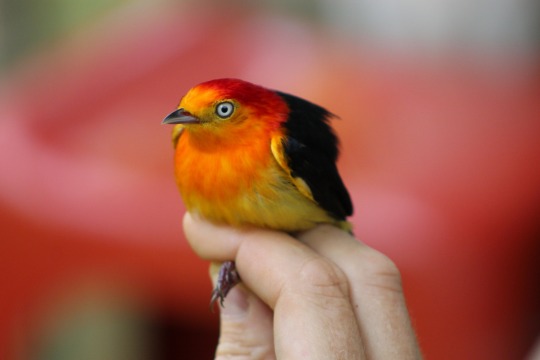


Although the main aim of my placement was obviously to help collect data and input it for the team, we also had the opportunity for some team bonding. We had a day off in which we hiked through the forest to a nearby lake for a day of relaxation and swimming. This really helped with getting to know the other interns whilst also helping us to relax and take a short break from our research.
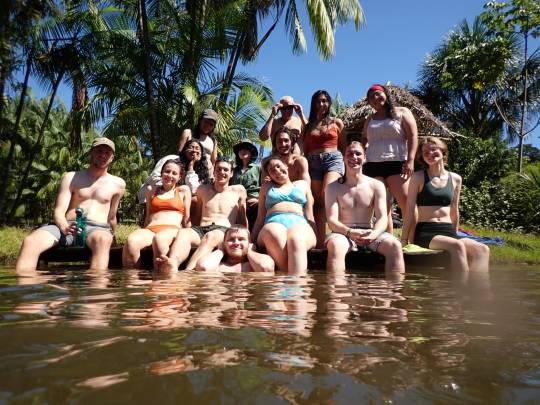

Not only that but by far the greatest experience that I had whilst on my placement was when we had the chance to go up a 40 meter tall observation tower in order to see the canopy-dwelling birds. Parrots, being my favourite order of birds, were in full view and the experience left me lost for words.
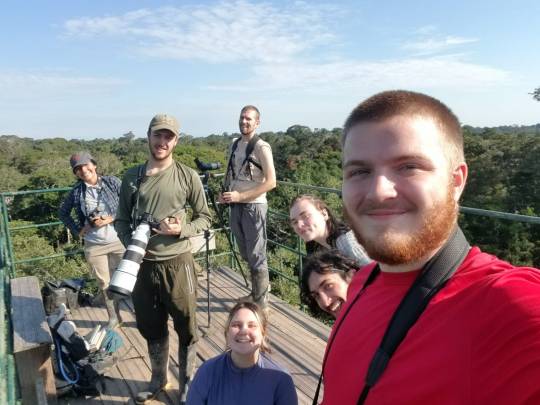

Now my trip was not without its trials. Unfortunately, only the day before my planned departure, I managed to break my toe which set up a world of trouble for getting me home. Not only was it my first broken bone, but it also delayed my flight a day whilst I was getting my medical treatment. Thankfully, the team I was with were absolutely brilliant and helped me every step of the way, both with translation at the doctors and airport and with comfort as it was all very overwhelming.
I got home safely, however, and was able to look back on my experience as something that has truly reignited my passion for birds and conservation. This trip not only gave me the opportunity to help gather research in the Amazon rainforest and gain skills that I couldn't otherwise obtain back in the UK, but it has also gained me friends that I will keep in contact with for life as well as invaluable skills as I go into my final year of university.
#biology#birds#ornithology#ecology#nature#wildlife#research#conservation#biodiversity#peru#the amazon
0 notes
Text
Conservation Research Placement in The Peruvian Amazon
Hello, I'm Rowan, and I'm an Ecology and Wildlife Conservation student at BournemouthUniversity. I chose the course because I'm passionate about environmental preservation and hope that, in getting my degree, I will be able to closely work towards achieving sustainable wildlife management across all continents. I decided to come to BU specifically after researching into the university and seeing all the conservation projects that they are personally involved with, such as BUG.
I had previously been a part of conservation research abroad with the same organisation, Operation Wallacea, that I worked with this time, and so knew that I already enjoyed the type of work that they carried out. I particularly chose to work in South America due to the immense diversity in wildlife, specifically birds, that you're able to find there. However, the different cultures and types of people that I was able to meet also drew me to the idea of working abroad.

As I had previously been in contact with Operation Wallacea, I had been receiving regular updates on all of their research station activity. So when I discovered their ongoing project in the flooded forests of the Peruvian Amazon, I emailed the team to inquire after the opportunities they had available and the amount if time that I would be permitted to stay at the research station. Applying for both my placement, and my funding through the university's Turing scheme was relatively simple and stress free and I was able to secure both after completing the required forms. Although the funding came through quite quickly, I first had to use my own savings to pay for both the flights out to Peru and the organisation I was staying with. I found that the funding covered the entirety of my 5 week stay jn Peru, but not the flights, which I had to fund myself.

Arriving in Peru was quite daunting. Although I had previously been to South America, this was the first time I'd ever been alone. I was able to find the people i was meeting easily enough and it was only a short trip to the research boat down the Amazon River and then off onto a channel called the Yarapa river. Settling in was quite difficult for me at first as my Spanish is not very good. That is definitely something I regret not practicing before going to Peru and, if I visit again, it would be something I would make sure to be confident in. Luckily, the scientist, Dr. Richard, and the field assistant that I was working with, both spoke English so I got by through communicating with them. Having been to the Amazon before, I expected similar sleeping arrangements; Tents and no hot water. However, on the boat, I got my own room, with a very nice en suite, and found it all very accommodating. That was one thing that made me feel more relaxed and less anxious about feeling homesick in a different country. Immediately it was clear that the staff members and team here were very friendly and keen to help out if I ever had any problems or questions. Being vegan, I was slightly worried about the meals I would be getting and if I would be a bother to the cooks, but it was explained to me that the research boat had previously seen many different dietary requirements and that I could talk to the cooks if I had any concerns. Apart from that initial worry, I have absolutely no complaints about the food. I love South American food, and the meals I received did not disappoint.

I was excited to hear all about the different surveys that I would be taking part in whilst staying at the research station, especially the bird orientated ones. In fact, the first survey I helped out on was a shorebird survey, in which we travelled out on a boat and recorded all of the different species, and individuals belonging to them, that we saw along a 5km transect. I felt confident, as I could already identify quite a few of them, and the field assistant was very helpful in explaining how to identify and birds that I couldn't already myself.

I found that the work I carried out during my traineeship was a good reflection of the work I'd done during the first year of my degree. I'm hoping to continue to guide my studies in the direction of field work after solidifying my love for it during my stay in Peru. It was hard for me, at first, to get used to the strict timings of the surveys, such as having to be ready to leave at 6am every morning, but I found that, by the end of my stay, I had gotten the hand of things. I loved being able to take a leading roles on the bird surveys, as I seemed to have a good knowledge on how to spot the different species. However, I quickly realised that surveys such as the fish one weren't really for me and so took a step back from those while continuing to focus heavily on the birds.
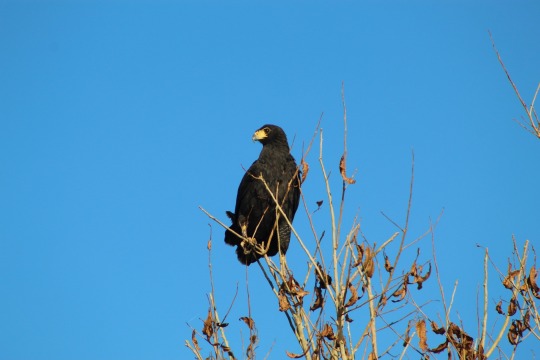
The working environment abroad is vastly different from that in the UK. This is mainly simply due to how wild it is in abroad work settings. It seemed a lot more informal to me, although still very strict on the ways the research is carried out and collected. Although, as the main language I'm working in is still English, it is still easy to communicate most of the time. I did attempt to improve my Spanish skills whilst abroad, however by the end of my trip found that, due to mostly conversing in English, it hadn't come very far.
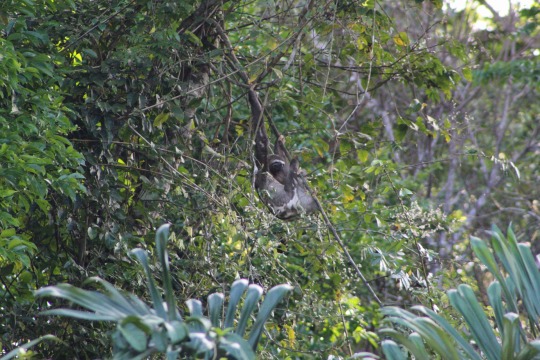
Working alongside community members who are actively allowed, and encouraged, to hunt within the areas we were studying was very interesting to me. It enabled me to understand how community based conservation actually benefits the ecosystems it's used in and how, although these people are taking from their environment, they are also a living part of it and are one of the most important factors in effective conservation.

Being able to link my knowledge, from previous study and my current degree course, to work in the field was extremely useful to me and helped me to solidify my comprehension of these subjects. It also enabled me to see what in learning actually being used in a work setting which was very promising and made me confident in my course choice.
Although I had an absolutely amazing time, my traineeship did help me to realise that I don't think I would be able to work oversees full time. After being away for almost two months, I had started to miss my family and friends back home a lot. In the future I would like to continue participating in projects abroad but not permanently. I would advise any other students wishing to take part in a traineeship abroad to make sure they have a strong support network back home, as it can be very daunting going off on your own at first and it helps to be able to send messages back home (when there's access to WiFi!). I would definitely recommend this experience to anyone who thinks they're up to it. It was definitely an amazing experience and showed me what I was capable of doing independently when I put my mind to it.

0 notes
Text
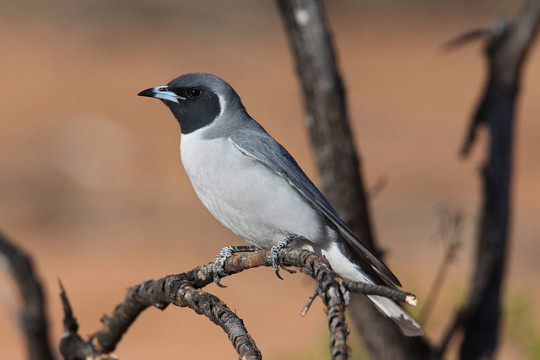

Masked woodswallow ~ Artamus personatus
The masked woodswallow is a common and highly nomadic bird in the family Artamidae. They are usually observed in large flocks alongside white-browed woodswallows, Artamus superciliosus, and are among the very few passerine species that are observed to have powdered down throughout their feathers.
The birds are widespread across Australia, although far less common near the coast and are usually seen in open forests, woodland and heathland.
The males and females of the species differ drastically, the males having a black-masked face with a very defined lighter outline. The upperparts of the ales are a blueish-grey with a prominent white tail tip whereas the underparts are a pale grey, fading to greyish-white on under tail coverts. Females have more brown underparts with a wholly indistinct face mask.
The masked woodswallow usually nests about 1-2 metres above the ground in shallow, frail bowls. These have been observed in tree stumps, bushes, fence posts and also fallen branches. The nesting material is comprised of twigs and grass, which is then lain with more grass. The eggs that are laid can be either pale greyish-white or pale greenish-grey or even light brown and are largely indistinguishable from the white-browed woodswallow, Artamus superciliosus.
9 notes
·
View notes
Photo


Eurasian blackcap ~ Sylvia atricapilla
The Eurasian blackcap, usually known as simply the blackcap, is a widespread typical warbler with mainly olive-grey upperparts and pale-grey underparts. The differences between the five subspecies are rather small. Between the sexes, however, they are quite noticeable, the males having the noticeable “blackcap” with the females having a more reddish-brown cap. The blackcap’s closest relative is the garden warbler, Sylvia borin, (see previous post). Although they don’t look similar, they do share a similar song.
The blackcap’s breeding grounds occur in most of Europe, western Asia and north-western Africa where the male sets up a territory in mature deciduous woodland. The male will defend its territory against other male blackcaps and also garden warblers. The nest resembles a cup shape built in low bushes or brambles and contains a clutch of between 4-6 eggs that are usually buff with grey and brown blotches and a few dark brown spots. Incubation takes about 11 days, after which the chicks will hatch in an altricial state and then fledge after 11-12 days of being fed by both parents. They leave the nest before they can fly and are then assisted with feeding for a further 2-3 weeks.
During the breeding season, blackcap’s feed mainly on insects in order to build up the protein needed for laying eggs and feeding chicks, but will then change to fruits in the summer time to give them the necessary sugars needed for bulking up in time for migration.
8 notes
·
View notes
Photo
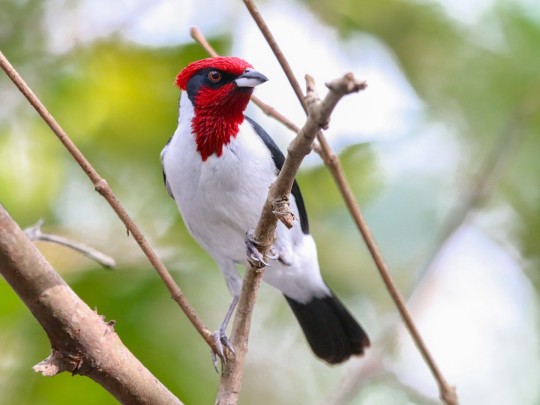
Masked cardinal ~ Paroaria nigrogenis
The masked cardinal is a species in the tanager family, Thraupidae and is not very closely related to the cardinals proper, Cardinalidae. It’s range covers Venezuela, Trinidad and north-eastern Columbia.
Previously, the masked cardinal was considered conspecific with the red-capped cardinal, Paroaria gularis, from which it differs by the black ear-coverts and the red,not black, lower throat and upper chest. As the two species’ ranges do not cross and Paroaria nigrogenis does not readily hybridise with Paroaria gularis, they were classified as separate species.
The masked cardinal is often found in groups of both adults and juveniles near water in riverine forests, scrub, and savanna, mostly in lowlands. In thse groups the birds have been observed to feed on a mix of seeds, vegetable matter, fruit and insects.
42 notes
·
View notes
Photo


Rose-bellied bunting or Rosita's bunting ~ Passerina rositae
The Rose-bellied bunting is a member of the family Cardinalidae, the cardinals or cardinal grosbeaks. Endemic to the foothills on Pacific slope in Mexico. It is often observed in woodland or brush in canyons with a permanent water source. Normally found singularly or in small groups feeding in seeding grasses or at all levels in fruiting trees.
Rose-bellied buntings are between 13.5 and 14.5cm in length and the sexes differ in appearance quite drastically. The males have a purplish-blue crown with very vibrant electric blue upperparts. The chin is mostly greyish with the chest being blue and the underparts fading from vibrant pink to a salmon pink towards the tail. However, the female’s upperparts are greyish-brown with a slight blue tinge towards the rump. Its underparts are pinkish and warmer on the throat becoming paler towards the lower belly.
132 notes
·
View notes
Photo

European robin ~ Erithacus rubecula
The European robin is an insectivorous passerine bird that has a large range across Europe, east to Western Siberia and south to North Africa. The bird is almost exclusively sedentary, except in the far north. Relatively small, about 12.5–14.0cm in length, the European robin is a frequent visitor in British gardens and are often observed having little to no fear of humans, especially when doing gardening which gives the birds the opportunity to hunt for earthworms. However, male robins are known for their aggressive behaviour towards other males that stray into their territory and have been observed to even attack their own reflection on occasion. It is estimated that this territorial nature can account for up to 10% of adult robin deaths in some areas.
Robins use a variety of locations for nest building, including crevices, sheltered banks and even man made objects such as upturned brooms, discarded kettle etc. A robin’s nest consists of moss, feathers, small twigs and grass that will see up to three clutches of five to six eggs that will be laid throughout the breeding season. The eggs laid are usually white or cream speckled with a reddish-brown colour. When the chicks fledge they are observed to be a mottled brown colour and have not yet earned their famous orange breast yet.
243 notes
·
View notes
Photo
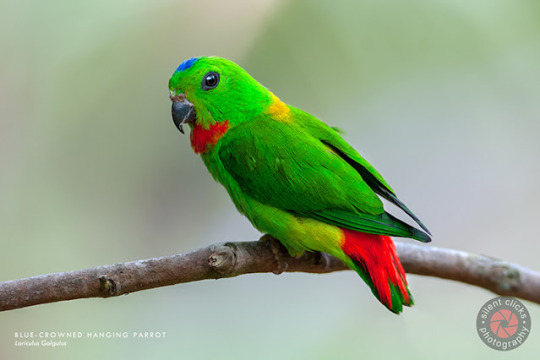

Blue-crowned hanging parrot ~ Loriculus galgulus
The blue-crowned hanging parrot is a mainly green parrot that is rather small, only reaching 13cm in length. It is found in the lowland forests of southern Burma and Thailand, Malaya, Singapore, and Indonesia.
The males and females of the species do differ in appearance. Typically, the males’ blue crown is much larger and more vibrant in colour and their red throat rarely occurs in the females. The females also lac the yellow lower back that the males posses.
Like others in the Loriculus genus, the blue-crowned hanging parrot also has the ability to sleep inverted, and is one of the only species of bird that can do so.
#blue-crowned hanging parrot#ornithology#Loriculus galgulus#birds#ecology#biology#nature#parrot#parrots#bat bird
38 notes
·
View notes
Photo


Guaiabero ~ Bolbopsittacus lunulatus
The Guaiabero is a smallish, stout parrot that is a member of the family Psittaculidae (subfamily Agapornithinae). It belongs to the monotypic, meaning it is the only species in said, genus Bolbopsittacus. Endemic to the Phillapienes, it gets its name due to its love of the guava fruit.
The males and females differ slightly in appearance, the males having more blue on the face and a darker grey beak. The females also have black crescent markings on the nape and rump. When breeding these birds have been observed to nest in dug out cavities in ant or termite nests in trees.
Four subspecies of lunulatus are recognised. The nominate race lunulatus occurs on Luzon, birds on Leyte are darker with a more distinctive blue collar and some purple-tinge on the face so are therefore classified as subspecies intermedius. The birds that are found on Mindanao and Panaon have greener cheeks and are classified as subspecies mindanensis. Lastly, those on Samar are similar to the Leyte subspecies, but with a more yellow tone overall and classified as callainipictus.
39 notes
·
View notes
Photo

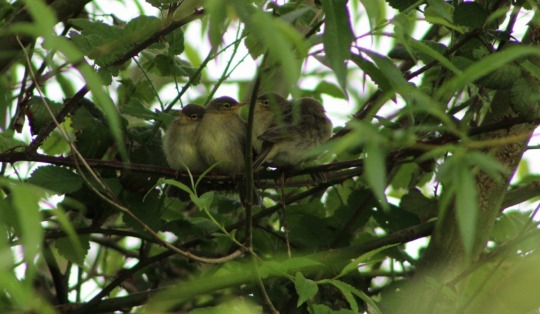
Garden warbler ~ Sylvia borin
The garden warbler is a small widespread passerine bird in the Sylviidae family. Their range encompasses most of Europe and parts of the Palearctic up to western Siberia. It is a typical warbler, in that it has long wings and wings, and brown upperparts with white underparts. There are two distinct subspecies of garden warbler, Sylvia borin borin and Sylvia borin woodwardi. They differ only slightly and do interbreed when their territories overlap.
Garden warblers lay a clutch of 4-5 blotched cream or white eggs in a cup-shaped nest built near to the ground. The chicks hatch after a period of 11-12 days incubation and are altricial at that point. They then fledge after around 10 days.
Strongly migratory birds, garden warblers winter in sub-Saharan Africa. Insects are the main food source during the breeding season, but this changes prior to migration and the birds switch to a diet consisting of mainly fruit; namely figs.
10 notes
·
View notes
Photo

Malherbe's parakeet; Māori: kākāriki karaka ~ Cyanoramphus malherbi
The Malherbe’s parakeet is a small parrot endemic to New Zealand, where it is known as the orange-fronted parakeet. In the 1990′s it’s population declined to just around 200 individuals and was therefore deemed critically endangered. It has a prominent orange band across it’s yellow crown that does not start to become apparent until the bird reaches 2-5 weeks old and is therefore mainly absent in juveniles. The rump of the bird is accompanied by orange patches which are considered brighter in male specimens.
Since it’s discovery, the Malherbe’s parakeet’s taxonomy has come under some scrutiny, at first, during the 18th century, being considered it’s own species, then in the 20th century a colour morph of the yellow-fronted parakeet and then since the 2000′s, after undergoing analysis using genetic molecular methods, again considered it’s own separate species.
The malherbe’s parakeet has been observed to feed in mixed flocks, feeding mainly on seeds, beech flowers and, in the spring, invertebrates.
9 notes
·
View notes
Photo

Black-Cheeked Lovebird ~ Agapornis nigrigenis
The birds are mainly green and have a brown head, red beak, and white eyerings. They are endemic to a relatively small range in southwest Zambia and may occur in Zimbabwe, Botswana and Namibia. The black-cheeked lovebird is listed as a vulnerable species due to habitat loss. This is mainly due to the consistent desiccation of water bodies, farming, hunting and logging. There are currently believed to be between 2500 and 9999 mature individuals of the species.
48 notes
·
View notes